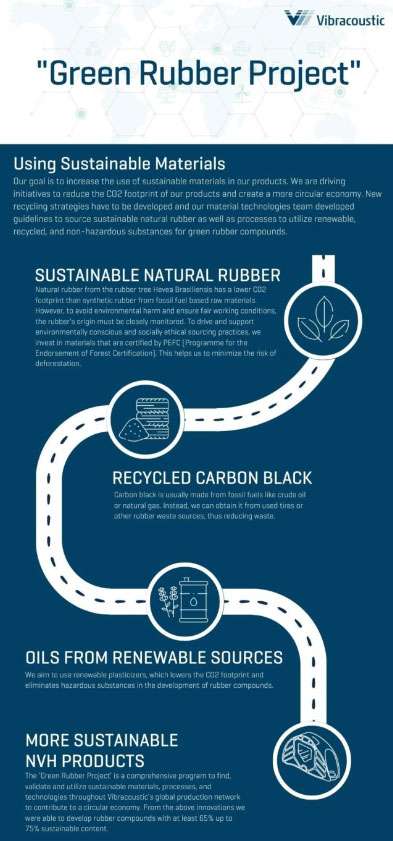German automotive noise, vibration and harshness (NVH) products supplier Vibracoustic says it is implementing new processes to sustainably source, manufacture, and recycle the rubber used in its products. The ‘Green Rubber Project’ is a comprehensive program to find, validate and utilise sustainable materials, processes, and technologies throughout Vibracoustic’s global production network to contribute to a circular economy.

As the automotive industry undergoes a monumental technological shift towards electrification, sustainability is high on the agenda. While much of the focus is on emissions reduction, equally critical to minimizing humanity’s impact is the sourcing of materials, recycling, and pursuit of a circular economy. This is where Vibracoustic as a global expert in the development of rubber compounds for complex automotive applications comes in. The company says it is positioned to also provide a significant part to drive what is required to make automotive NVH more sustainable.
Currently, the international rubber industry is far from circular, generating large quantities of discarded material. Besides continuous improvements regarding waste reduction, new recycling strategies must also be at the heart of any attempt to address rubber waste. That is why Vibracoustic’s Material Technologies Team has launched the Green Rubber Project – a program intent to identify sustainable sources of rubber supply, sustainable alternatives to standard rubber additives, and investigate innovative methods to recycle natural rubber waste.
When the project was initially kicked off in 2016, the Material Technologies Team first developed guidelines to source sustainable natural rubber, including processes to help utilize renewable, recycled, and non-hazardous substances for green rubber compounds. Through rigorous research and testing, the team was able to develop rubber compounds with up to 75% sustainable content without any compromise in performance, durability, or manufacturing – a substantial and important success.
An area of clear interest was natural rubber, as it can cut reliance on synthetically produced rubber derived from fossil fuel-based raw materials. With a clear CO2 footprint advantage, natural rubber harvested from the Hevea Brasiliens tree is deemed to be far more sustainable, though the team highlighted the importance of closely monitoring the natural rubber’s origin. This concern comes from both an environmental impact perspective, as well as consideration of fair working conditions in harvesting and production.
To that end, Vibracoustic has invested in materials certified by the Program for the Endorsement of Forest Certification (PEFC), a leading global alliance of national forest certification systems. The PEFC promotes sustainable forest management through independent third-party certification throughout the entire forest supply chain to ensure that forest-based products are produced with respect for the highest ecological, social, and ethical standards. Vibracoustic is also a member of the Global Platform for Sustainable Natural Rubber (GPSNR), an international organization focused on improving the socioeconomic, ethical, and environmental performance of the entire natural rubber value chain.
Carbon black is a key raw material for the rubber industry, used to strengthen and colour rubber. Derived from fossil fuels, it is used extensively in the production of tyres, one of the largest contributors to rubber waste in the world. As part of the Green Rubber Project, Vibracoustic has investigated recovered carbon black from tyres, as well as innovative, renewable plasticisers. Both of these materials result in carbon footprint reduction and help contribute to a circular economy for rubber. As part of this project, Vibracoustic is also working to eliminate hazardous substances in rubber compounds, thus improving the working conditions and safety of production workers.
Central to the circular economy is effective and comprehensive recycling. To date, this is one of the greatest challenges facing the global rubber industry, including automotive applications. Biotechnical recycling provides great potential on this matter. This breakthrough technology – a collaboration project between Vibracoustic, Freudenberg Technology Innovation, and ASA Spezialenzyme, Germany – enables the effective recycling of rubber waste. Also, the German Federal Ministry of Education and Research (BMBF) supports this project.
During the process, called BioReNa, vulcanised grinded rubber is treated with enzymes, which functionalize the surface of the rubber, converting it into valuable material that can be reused for new rubber compounds and products. By reusing its own waste, Vibracoustic can simultaneously reduce the carbon footprint of new products while cutting the waste generated by its own production processes – the benefits of a circular product lifecycle.
